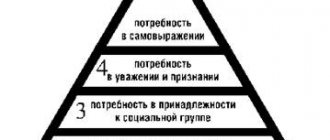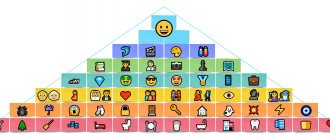In this article we will tell you:
- Concept of human needs
- Scientific theories about human needs
- The order of formation of human needs
- Differences between needs and wants
- Specifics of meeting human needs
Human needs are varied and difficult to classify. However, scientists have proposed several methods for grouping and evaluating them. There are several popular theories on this matter.
At first glance, it may seem that needs are a natural part of our lives and we ourselves know our needs best. This is partly true, but understanding how they are formed, what ways exist to satisfy them, and what is the difference between needs and “wants” will help to improve your life qualitatively.
In our article we will tell you what the nature of human desires is, what they are, and also how they can be closed.
Concept of human needs
In society, it is customary to divide all human needs and requirements into three groups: physiological, spiritual and social. People view need in one area differently, depending on their upbringing and education, personal characteristics and level of culture. When a person feels a clear gap in one area of his life, he has two options: do everything in his power to satisfy the need, or abandon it.
A person feels a need in one of the spheres of life through need.
What is a need? This is an urgent need to possess some benefits, goods or services that give the individual pleasure or satisfaction. You can give other definitions to the concept, for example, economic, when a need is a conscious need for something specific; the individual’s personal attitude towards things and objects; a feeling of dissatisfaction in something and a desire to improve one’s condition; desire to provide better living conditions, etc.
We can talk a lot about human needs for a long time. If we mean physiological needs inherent in nature, then their satisfaction is the basis for the possibility of life in general. But in addition to physiological ones, there are also social needs of a person, which arise as civilization develops, change, become more complex and undergo various transformations along with the development of society.
Social needs of the individual
This is a special kind of human need. It lies in the need to have everything necessary for the existence and functioning of an individual, a social group, or society as a whole. This is an internal motivating factor for activity.
Social needs are the need of people for work, social activity, culture, and spiritual life. The needs created by society are those needs that are the basis of social life. Without motivating factors to satisfy needs, production and progress in general are impossible.
Social needs also include those associated with the desire to form a family, joining various social groups, teams, various areas of production (non-production) activity, and the existence of society as a whole. Conditions and environmental factors that surround an individual in the process of his life not only contribute to the emergence of needs, but also create opportunities to satisfy them. In human life and the hierarchy of needs, social needs play one of the determining roles. The existence of an individual in society and through it is the central area of manifestation of the essence of man, the main condition for the realization of all other needs - biological and spiritual.
Social needs are classified according to three criteria: the needs of others, their own needs, and common needs.
The needs of others (needs for others) are needs that express the generic basis of the individual. It lies in the need for communication, protection of the weak. Altruism is one of the expressed needs for others, the need to sacrifice one's interests for others. Altruism is realized only through victory over egoism. That is, the need “for oneself” must be transformed into a need “for others.”
One’s own need (need for oneself) is expressed in self-affirmation in society, self-realization, self-identification, the need to take one’s place in society and the team, the desire for power, etc. Such needs are therefore social, because they cannot exist without needs “for others.” " Only through doing something for others is it possible to realize your desires. Take some position in society, i.e. It is much easier to achieve recognition for oneself without affecting the interests and claims of other members of society. The most effective way to realize your egoistic desires will be a path along which a share of compensation is contained to satisfy the claims of other people, those who can claim the same role or the same place, but can be satisfied with less.
Joint needs (needs “together with others”) - express the motivating power of many people at the same time or society as a whole. For example, the need for security, freedom, peace, a change in the existing political system, etc.
Scientific theories about human needs
The concept of needs has many classifications. In psychology, these are known as need theories. At the same time, it is possible that you may call some of the theories strange and illogical. But everything that we indicate in the article is the basis of the theory of psychology. We suggest that you do not waste time on biased criticism and consider in detail each of the available theories. Most likely, you are already familiar with them, at least superficially.
Maslow's pyramid is one of the most famous theories
Maslow's pyramid is embedded in almost every branch of knowledge. It is studied in the basis of psychology, medicine and law. What is the generally accepted Maslow pyramid?
We invite you to figure it out together:
- The author of the theory is researcher Abraham Maslow, after whom the pyramid of the same name is named.
- According to the theory, human needs are divided into primary and secondary.
- According to Maslow's pyramid, a person acts based on the satisfaction of needs, which are arranged in a certain hierarchical sequence. They are the basis for man.
Needs are updated gradually
Higher needs can sleep while lower ones are actively being satisfied.
The needs for achievement and self-realization may not be relevant for the time being, while the most important thing is family or creating relationships, or gaining at least some kind of financial and physical security. But if the need has become actualized, i.e. This has already become important, then the unsatisfaction of the need causes physical or emotional hunger.
The same applies to earlier needs, such as physical, financial and emotional security or the need for sex. An unsatisfied need, internal hunger causes tension and discomfort.
The order of formation of human needs
Having an idea of the classification of needs, you can move on to the topic of the features of their occurrence. A person receives primary, or basic, needs upon birth; they are provided genetically. Without physiological needs, a person simply will not survive, so their satisfaction comes first until death.
These needs cannot be obtained through violence or, conversely, canceled. They cannot be assessed as good or bad, only the way they are satisfied can be assessed. Thus, the very desire to go to the toilet cannot be obscene. But using a public place instead of a toilet to satisfy this need can.
Along with physiological ones, primary spiritual needs also appear. So, from birth, a person needs love, harmony, a friendly environment, a safe space. For the normal functioning of the psyche, he needs self-realization and close people nearby. Of course, in the absence of all this, a person will not die, but will become mired in reflection.
Secondary spiritual needs do not appear immediately, but are formed gradually.
- Infancy. Parents are responsible for meeting the infant's physiological needs. Since a child grows up in close contact with adults, by the age of 6 months his social needs are formed: he learns to smile, play with rattles, and clearly identify his mother, father or other close adult.
- Early childhood. Already at 3 years old, the child begins to understand that to satisfy his needs he needs certain toys, clothes, and food. The baby actively explores the world, sculpts, reads, draws, plays.
- Preschool period, primary school age. The child's environment expands greatly. He starts going to kindergarten or to clubs. He makes other significant adults and friends - children. The child needs communication, help, recognition.
- Teenagers. The period of appearance of the last physiological need - sexual. The teenager is faced with the need for self-realization and self-improvement. His educational interests are growing. The teenager begins to become interested in things and objects that he had not even thought about before. The emerging sexual need creates a need in the opposite sex, a desire to experience romantic emotions. The basis of communication is now built on friends; relatives and parents fade into the background.
By the end of adolescence, all basic human needs are considered to be formed. In the future, their development and transformation occur through changes in their content and methods of implementation and satisfaction.
Psychological needs of the individual
The psychological needs of an individual are those needs that are not limited to bodily needs, but also do not reach the level of spiritual ones. Such needs usually include the need for affiliation, communication, etc.
The need for communication in children is not an innate need. It is formed through the activity of surrounding adults. Usually it begins to actively manifest itself by two months of life. Adolescents are convinced that their need for communication brings them the opportunity to actively use adults. For adults, insufficient satisfaction of the need for communication has a detrimental effect. They become immersed in negative emotions. The need for acceptance is the desire of an individual to be accepted by another person, a group of people or society as a whole. Such a need often pushes a person to violate generally accepted norms and can lead to antisocial behavior.
Among the psychological needs, basic needs of the individual are distinguished. These are needs that, if not met, young children will not be able to fully develop. They seem to stop in their development and become more susceptible to certain diseases than their peers who have such needs met. For example, if a baby is regularly fed but grows without proper communication with his parents, his development may be delayed.
The basic personal needs of adults of a psychological nature are divided into 4 groups: autonomy - the need for independence, independence; need for competence; the need for interpersonal relationships that are significant for the individual; the need to be a member of a social group and to feel loved. This also includes a sense of self-worth and the need to be recognized by others. In cases of unsatisfaction of basic physiological needs, the physical health of the individual suffers, and in cases of unsatisfaction of basic psychological needs, the spirit (psychological health) suffers.
Differences between needs and wants
Needs and desires are not the same thing. There are differences.
| Needs | Desires |
| 1. Needs are always constructive. Human needs indicate the importance and primacy of their satisfaction for the possibility of further functioning and life. 2. The basis of the need is always something important and deep. 3. Thanks to the satisfaction of needs, a person finds harmony with himself. | 1. They are destructive in nature. May harm personal development and life. So, drug addiction is a “wish”, not a need. 2. Other people can impose “wants.” 3. Desires may be superficial and not satisfy the true needs of a person. |
Let's try to figure it out with an example. Imagine that you live in your own apartment and dream of a summer house. You don't have enough money to buy a summer house, so you're angry. In this case, giving is a desire. But if you have nowhere to live, then buying any housing is satisfying a need.
Why is it necessary to distinguish between needs and desires? This is necessary for proper distribution of energy and resources. It also makes it possible to better understand yourself and others. Well, besides, seeing the differences, a person will be able to set priorities correctly.
To make the task easier, just honestly answer the following questions:
- Is it possible to do without this? A fashionable dress is a desire, but not a need. You can put it aside and buy it when there are enough opportunities for this.
- What will I get? The answer to this question will help you understand the nature of the origin of what you want.
- Will this purchase limit me? Desires should not interfere with the satisfaction of needs. Always prioritize.
Material and intangible benefits
All those means that are aimed at satisfying our needs can be both intangible and material, that is, tangible. Intangible goods are those values that are created through non-productive means. They can contribute to the development of human abilities and serve to satisfy the spiritual needs of people. These include art and reputation. These benefits are divided into internal ones, that is, those that are given to a person by nature (perfect pitch, a singing voice, a poetic beginning, the ability to draw and sculpt). Otherwise, we call them talents. But external intangible benefits are what we receive from the outside also to satisfy our needs (connections, reputation, relationships with friends and colleagues). By the way, if you noticed, the concept of good has a direct connection with another philosophical concept - value. It’s just that what is valuable to one may mean nothing to another.










